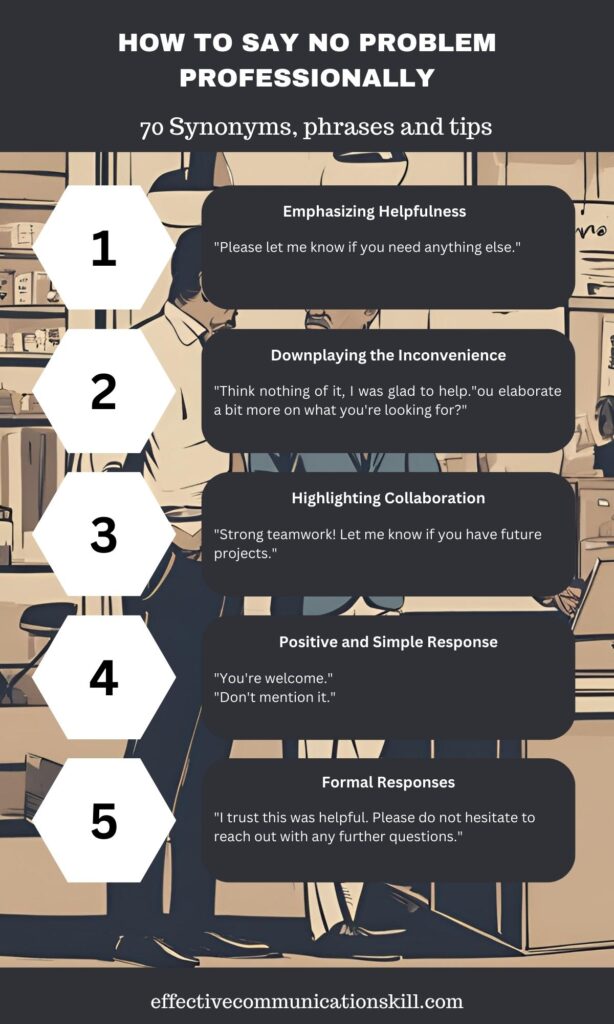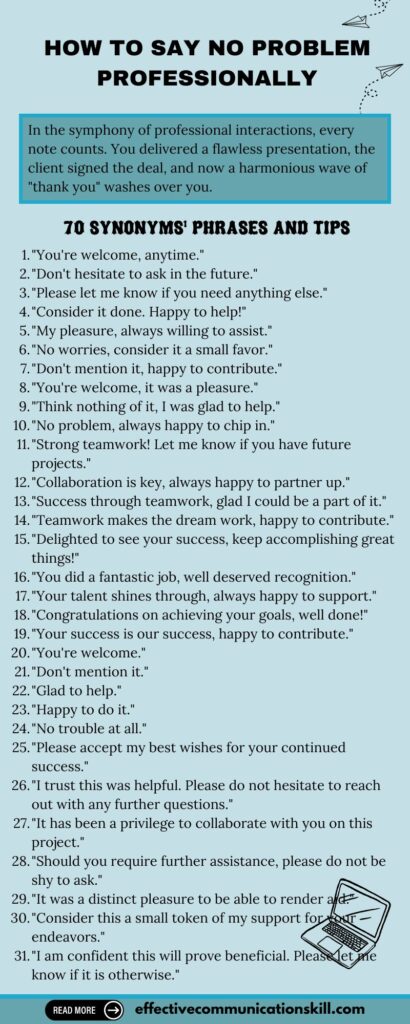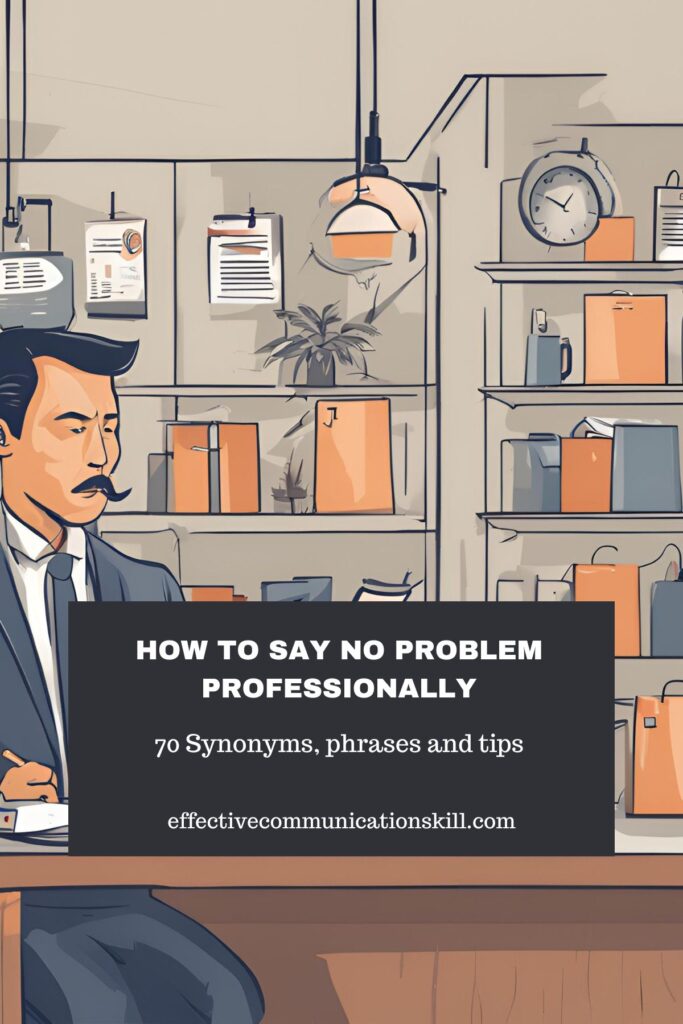How to Say No Problem Professionally
In the symphony of professional interactions, every note counts. You delivered a flawless presentation, the client signed the deal, and now a harmonious wave of “thank you” washes over you. But how do you respond?
The predictable “no problem” might leave your audience feeling a flat note. Imagine instead crafting a response that resonates with warmth, sincerity, and professionalism, leaving a lasting impression that elevates the entire performance.
How to Professionally Say No Thank You – This guide is your conductor, offering a variety of responses that will ensure every exchange ends on a powerful and positive key.

How to Say No Problem Professionally
Moving beyond “no problem” demonstrates your professionalism and willingness to go the extra mile. Here are five key strategies to say no problem to elevate your response when someone thank you:
Emphasize Your Pleasure to Assist:
Example: “You’re welcome, Sarah. I was happy to help with the presentation.”
Reiterate Support and Availability:
Example: “Absolutely, John. Don’t hesitate to reach out if you have any further questions.”
Convey Teamwork and Shared Success:
Example: “My pleasure, Michael. It was a great team effort to get the project completed on time.”
Minimize the Inconvenience:
Example: “Of course, Lisa. It was a minor request, and I’m glad I could assist.”
Offer Future Assistance Proactively:
Example: “Happy to help, David. Please let me know if there’s anything else I can do for you on this project.”
70 Ways to Say No Problem Professionally
With a variety of options at your disposal, you can tailor your response to the specific situation and your relationship with the person. Here are other ways to say no problem to express your willingness to help, downplay any inconvenience, highlight collaboration, or shift the focus to the recipient’s success:
Phrases Emphasizing Helpfulness:
- “Absolutely, my pleasure.”
- “Happy to lend a hand.”
- “Glad I could be of service.”
- “Always happy to help out.”
- “You’re welcome, anytime.”
- “Don’t hesitate to ask in the future.”
- “Please let me know if you need anything else.”
- “Consider it done. Happy to help!”
- “My pleasure, always willing to assist.”
Phrases Downplaying the Inconvenience:
- “Not a problem at all.”
- “Certainly, no trouble.”
- “Of course, I was happy to do it.”
- “Absolutely, it was the least I could do.”
- “No worries, consider it a small favor.”
- “Don’t mention it, happy to contribute.”
- “You’re welcome, it was a pleasure.”
- “Think nothing of it, I was glad to help.”
- “No problem, always happy to chip in.”
Phrases Highlighting Collaboration:
- “It was a pleasure working together.”
- “Great teamwork, glad we could achieve this.”
- “Excellent collaboration, let’s do it again soon.”
- “We make a great team, happy to contribute.”
- “Joint effort well done, always happy to collaborate.”
- “Strong teamwork! Let me know if you have future projects.”
- “Collaboration is key, always happy to partner up.”
- “Success through teamwork, glad I could be a part of it.”
- “Teamwork makes the dream work, happy to contribute.”
Phrases Shifting Focus to the Recipient’s Success:
- “You’re welcome, well deserved!”
- “Congratulations on your success!”
- “Glad I could play a small role in your achievement.”
- “Your hard work paid off, well done!”
- “Delighted to see your success, keep accomplishing great things!”
- “You did a fantastic job, well deserved recognition.”
- “Your talent shines through, always happy to support.”
- “Congratulations on achieving your goals, well done!”
- “Your success is our success, happy to contribute.”
Positive and Simple Responses:
- “Certainly.”
- “Absolutely.”
- “Of course.”
- “Sure thing.”
- “You’re welcome.”
- “Don’t mention it.”
- “Glad to help.”
- “Happy to do it.”
- “No trouble at all.”

Formal Responses:
- “My pleasure to be of assistance.”
- “I was happy to contribute in any way I could.”
- “Please accept my best wishes for your continued success.”
- “I trust this was helpful. Please do not hesitate to reach out with any further questions.”
- “It has been a privilege to collaborate with you on this project.”
- “Should you require further assistance, please do not be shy to ask.”
- “It was a distinct pleasure to be able to render aid.”
- “Consider this a small token of my support for your endeavors.”
- “I am confident this will prove beneficial. Please let me know if it is otherwise.”
The Art of Responding: Beyond “No Problem”
While “no problem” is a common response, it can sometimes feel dismissive or impersonal. Mastering the art of responding to gratitude demonstrates your professionalism, strengthens relationships, and creates a more positive work environment. Here are some additional considerations to elevate your responses:
- Sincerity is Key: Deliver your response with a genuine smile and positive tone. A heartfelt “You’re welcome” can be far more impactful than a monotone “no problem.”
- Body Language Matters: Maintain good posture, make eye contact, and offer a friendly nod when responding. Non-verbal cues can significantly enhance your message.
- Follow Up When Necessary: If you offered additional help, follow up later to see if they needed anything else. This shows you’re genuinely invested in their success.
Examples:
Scenario: A colleague thanks you for helping them brainstorm ideas for a presentation.
Enhanced Response: “You’re welcome! I enjoyed brainstorming with you. Did you come up with a solid plan for your presentation?” (This shows your enthusiasm and offers continued support)
Scenario: Your manager thanks you for taking on an extra task to meet a deadline.
Enhanced Response: “Absolutely, I was happy to contribute. The team’s success is important to me. Is there anything else I can do to help ensure we meet the deadline?” (This demonstrates initiative and commitment)
Scenario: A client thanks you for resolving a technical issue they were experiencing.
Enhanced Response: “You’re welcome! I’m glad we could get your issue resolved quickly. Please don’t hesitate to reach out if you have any further questions.” (This shows you prioritize customer satisfaction)
Scenario: A junior team member thanks you for mentoring them on a new project.
Enhanced Response: “Absolutely, I was happy to help! It’s rewarding to see your progress. Is there anything else you’d like to learn about this project?” (This encourages further learning and fosters a supportive environment)
Scenario: A colleague thanks you for covering for them while they were out sick.
Enhanced Response: “No problem at all! I hope you’re feeling better now. Is there anything I can do to help you catch up on missed work?” (This shows you care about their well-being and are willing to go the extra mile)

Conclusion
In the grand scheme of professional interactions, responding to “thank you” might seem like a minor detail. But these seemingly small moments hold immense power.
By choosing impactful responses over a rote “no problem,” you’re weaving a tapestry of positive interactions. Each “absolutely, my pleasure” or “congratulations on your success” strengthens the threads of trust, collaboration, and respect within your professional circle.
So, the next time gratitude comes your way, remember, it’s an opportunity. Seize it, express your willingness to help, and watch your professional network flourish, one heartfelt response at a time.
